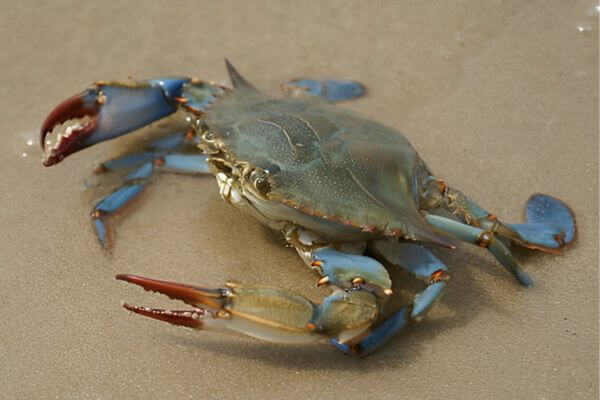In this article, we’ll explore the role humanity has played in introducing the Blue Crab to new areas. From the careless disposal of crab shells from other species, which can inadvertently carry eggs and larvae of this crab species, to dumping aquariums and using them as fishing bait, every human action plays a crucial role in this process.
Through these seemingly harmless actions, the Blue Crab finds its way to unknown habitats, triggering a series of ecological challenges. It is therefore essential that we address the importance of proper disposal practices and strict regulations to prevent the spread of the invasive species into native ecosystems. A deep understanding of these factors proves to be essential to mitigate negative impacts and implement effective management strategies.

.
Historical events of introduction of the Blue Crab
In the 19th century, the Blue Crab was accidentally transported to new regions, such as the Gulf of Mexico in the United States, during the expansion of shipping. In the early 20th century, it was also intentionally introduced into areas such as the North Pacific, targeting commercial fisheries. In addition, the crustacean was brought to the Mediterranean Sea by sea transport.
In this way, it established itself in regions such as the coast of Italy and Greece. In other parts of the world, such as South Africa, Australia and Asia, introductions have also occurred. These historical events reveal the patterns of spread and the factors that allowed its establishment in new areas.
Introduction routes
The investigation of the introduction routes reveals that the Blue Crab was brought to different areas by means of maritime transport, mainly by ballast water from commercial ships, which inadvertently transported larvae, juveniles or adult crabs of the species. In addition, the trade in live animals, especially for aquariums, contributed to the dispersion of the crustacean, as these animals escaped or were intentionally released.
In addition to the routes of introduction by maritime transport and trade, natural migrations also played an important role in the expansion of the Blue Crab, taking advantage of ocean and tidal currents to colonize distant areas. These routes of introduction were crucial to global spread and successful establishment in new regions.
What are the facilitating factors for the introduction of the invasive species?
The successful introduction of the Blue Crab into new areas can be attributed to specific facilitating factors. One of these factors is the remarkable resistance of this species to variations in salinity, being able to survive and reproduce, allowing its adaptation to different coastal and estuarine environments. In addition, this species demonstrates a remarkable ability to adapt to different habitats, which facilitates its colonization in areas with varied environmental conditions.
This adaptability allows this crustacean to explore new resources and establish itself in previously unoccupied habitats. Lastly, their high reproductive capacity plays a key role in their successful introduction into new areas, with the ability to produce large numbers of eggs and a rapid reproduction rate, which contributes to rapid population growth in favorable environments.
Accidental versus intentional introductions
The introduction of the Blue Crab into new areas can occur both accidentally and intentionally. In accidental introductions, there is the unintentional transport of larvae or adult crabs through the ballast water of vessels. This introduction route is often associated with maritime transport and can lead to the dispersal of the species in different regions.
On the other hand, intentional introductions occur when the Blue Crab is deliberately brought in for specific purposes such as commercial fishing, aquaculture or pest control. In these cases, the objective is to establish populations of the species in new areas to meet the demand for fishery resources, captive cultivation or pest control in specific ecosystems. These introductions, both accidental and intentional, have significant implications for distribution and impact on different ecosystems.
What are the effects of the lack of natural predators?
The introduction of the Blue Crab into areas where there are no natural predators has significant consequences for local ecosystems, including:
- Lack of predators: Without the presence of predators that would normally control its population, this crustacean species can successfully establish itself and proliferate unchecked. This population overabundance can lead to negative impacts on native ecosystems, including competition for food resources and damage to native species.
- It feeds on several species: The Blue Crab is a voracious and opportunistic predator, capable of feeding on a wide variety of organisms, such as molluscs, crustaceans and small fish.
- Habitat alteration: Their presence in large numbers can negatively affect populations of native species, causing ecological imbalances. In addition, it is known to modify the habitats it occupies, by digging burrows and removing aquatic vegetation.
These changes in the environment can affect the structure and function of ecosystems, harming other species and reducing local biodiversity. Therefore, understanding the effects of the introduction of the Blue Crab in ecosystems without natural predators is essential for the proper management of this invasive species and the conservation of native ecosystems.
What is the role of the seafood trade in the dispersal of the Blue Crab?
The international seafood trade plays a significant role in the dispersal of the Blue Crab to new areas. This occurs through the transport of live specimens, such as adult crabs destined for aquaculture, and also through the trade of fishery products, in which Crab eggs and larvae may be present.
The transport of live specimens and trade in fishery products may result in the introduction of this invasive species into areas where it was not native, posing a risk to coastal and estuarine ecosystems. It is essential to regulate and monitor the seafood trade to control the spread of invasive species and avoid negative impacts on native ecosystems.
How did the human contribution influence the introduction of the Blue Crab?
Human activities play a significant role in introducing this species to new areas. One of the main contributions is:
- Improper disposal of crab shells from other species. When shells are discarded in coastal waters, they may contain Blue Crab eggs or larvae, allowing their dispersal and establishment in new habitats.
- Dumping aquariums is another source of introduction. Often aquarists deliberately discard Blue Crab in natural water bodies, thinking they are “setting free” the pet. However, these released individuals can reproduce and colonize the environment, becoming an invasive species.
- The use of blue crab as bait in fishing can also lead to its introduction in new areas, as eggs and larvae can be present in packages or released into the environment during fishing. These human contributions underscore the importance of proper disposal and regulatory practices to prevent dispersal and encroachment on native ecosystems.
Finally, it is critical to adopt proper disposal practices, regulate the seafood trade and raise awareness of the risks associated with the introduction of the Blue Crab. In addition, management and control strategies must be implemented to limit its dispersal and minimize negative impacts on native ecosystems.
Understanding historical events, dispersal routes and enabling factors is crucial to developing effective prevention and mitigation approaches against invasive species in new areas. Only with joint efforts and appropriate measures will we be able to protect coastal and estuarine ecosystems from the threat posed by this invasive species.

